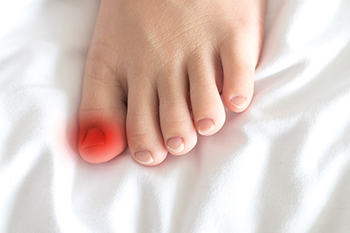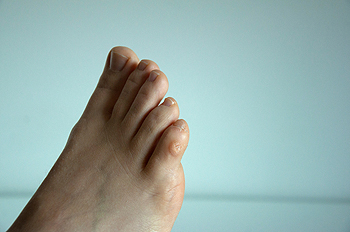Connect With Us
Blog
Items filtered by date: July 2023
Why Did I Develop an Ingrown Toenail?

An ingrown toenail is a common foot condition that can quickly become infected. This ailment is defined as the toenail growing into the skin instead of over it. It can happen for various reasons, including trimming the toenails incorrectly and wearing shoes too tight around your toes. Additionally, some people may have an abnormal nail structure or may have genetic tendencies toward developing an ingrown toenail. Common symptoms can consist of redness, extreme tenderness, and an infected nail may ooze pus. An ingrown toenail is generally a painful condition, and prompt medical attention is often sought for relief. Soaking the feet in warm water, followed by gently pushing the nail away with a small piece of cotton may bring temporary relief. If you have developed an ingrown toenail, it is suggested that you confer with a podiatrist who can provide you with permanent relief options and offer effective prevention methods.
Ingrown toenails can become painful if they are not treated properly. For more information about ingrown toenails, contact Manisha Mehta, DPM of Detroit, MI. Our doctor can provide the care you need to keep you pain-free and on your feet.
Ingrown Toenails
Ingrown toenails occur when a toenail grows sideways into the bed of the nail, causing pain, swelling, and possibly infection.
Causes
- Bacterial infections
- Improper nail cutting such as cutting it too short or not straight across
- Trauma to the toe, such as stubbing, which causes the nail to grow back irregularly
- Ill-fitting shoes that bunch the toes too close together
- Genetic predisposition
Prevention
Because ingrown toenails are not something found outside of shoe-wearing cultures, going barefoot as often as possible will decrease the likeliness of developing ingrown toenails. Wearing proper fitting shoes and using proper cutting techniques will also help decrease your risk of developing ingrown toenails.
Treatment
Ingrown toenails are a very treatable foot condition. In minor cases, soaking the affected area in salt or antibacterial soaps will not only help with the ingrown nail itself, but also help prevent any infections from occurring. In more severe cases, surgery is an option. In either case, speaking to your podiatrist about this condition will help you get a better understanding of specific treatment options that are right for you.
If you have any questions please feel free to contact our office located in Detroit, MI . We offer the newest diagnostic and treatment technologies for all your foot and ankle needs.
What Can Cause Flat Feet in Adults?

Flat feet are exactly what its name implies. The bottom of the foot lies flat on the ground, due to having little or no arch. Most babies are born with flat feet, and the arch typically develops during the teenage years. Adults with flat feet may have endured a foot injury or been born with an abnormal foot structure. Additionally, obesity, diabetes, high blood pressure, or rheumatoid arthritis may cause flat feet, as well as genetic reasons. Some patients who have flat feet and experience pain in various parts of the foot and ankle may choose to wear orthotics for mild relief. Severely flat feet may affect balance, and the feet may become stiff. If you have flat feet, it is suggested that you consult with a podiatrist who can offer you relief options that are suitable for you.
Flatfoot is a condition many people suffer from. If you have flat feet, contact Manisha Mehta, DPM from Detroit, MI. Our doctor will treat your foot and ankle needs.
What Are Flat Feet?
Flatfoot is a condition in which the arch of the foot is depressed and the sole of the foot is almost completely in contact with the ground. About 20-30% of the population generally has flat feet because their arches never formed during growth.
Conditions & Problems:
Having flat feet makes it difficult to run or walk because of the stress placed on the ankles.
Alignment – The general alignment of your legs can be disrupted, because the ankles move inward which can cause major discomfort.
Knees – If you have complications with your knees, flat feet can be a contributor to arthritis in that area.
Symptoms
- Pain around the heel or arch area
- Trouble standing on the tip toe
- Swelling around the inside of the ankle
- Flat look to one or both feet
- Having your shoes feel uneven when worn
Treatment
If you are experiencing pain and stress on the foot you may weaken the posterior tibial tendon, which runs around the inside of the ankle.
If you have any questions, please feel free to contact our office located in Detroit, MI . We offer the newest diagnostic and treatment technologies for all your foot care needs.
Plantar Warts Can Be Treated!
Effective Stretches for the Feet and Toes

There are simple stretches that can be done which can improve the strength and flexibility of the feet. This is also true for reducing existing foot pain when practiced several times per week. Toe raises are effective in keeping the toes strong and are begun by sitting in a chair with the feet on the floor. This is followed by raising the heels and keeping the toes steady on the floor while slowly curling the toes inward. Practicing toe splays can help to improve control over the toe muscles. This can easily be done by sitting in a chair and spreading the toes as far apart as possible without straining. It is helpful to repeat this stretch several times. The big toe can be stretched by placing one foot over the opposite thigh while gently pulling the big toe up and down. It can also be rotated from side to side. The soles of the feet can become stronger by picking up marbles one at a time with the toes and placing them in a small bowl. This can be repeated several times on each foot. If you would like to have more information about effective foot and toe stretches, it is suggested that you confer with a podiatrist who can provide you with useful tips.
Why Stretching Is Important for Your Feet
Stretching the feet is a great way to prevent injuries. If you have any concerns with your feet consult with Manisha Mehta, DPM from Detroit, MI. Our doctor will assess your condition and provide you with quality foot and ankle treatment.
Stretching the Feet
Stretching the muscles in the foot is an important part in any physical activity. Feet that are tight can lead to less flexibility and make you more prone to injury. One of the most common forms of foot pain, plantar fasciitis, can be stretched out to help ease the pain. Stretching can not only ease pain from plantar fasciitis but also prevent it as well. However, it is important to see a podiatrist first to determine if stretching is right for you. Podiatrists can also recommend other ways to stretch your feet. Once you know whether stretching is right for you, here are some excellent stretches you can do.
- Using a foam roller or any cylindrical object (a water bottle or soda can will do), roll the object under your foot back and forth. You should also exert pressure on the object. Be sure to do this to both feet for a minute. Do this exercise three times each.
- Similar to the previous exercise, take a ball, such as a tennis ball, and roll it under your foot while seated and exert pressure on it.
- Grab a resistance band or towel and take a seat. If you are using a towel, fold it length wise. Next put either one between the ball of your foot and heel and pull with both hands on each side towards you. Hold this for 15 seconds and then switch feet. Do this three times for each foot.
- Finally hold your big toe while crossing one leg over the other. Pull the toe towards you and hold for 15 seconds. Once again do this three times per foot.
It is best to go easy when first stretching your foot and work your way up. If your foot starts hurting, stop exercising to ice and rest the foot. It is advised that you then see a podiatrist for help.
If you have any questions please contact our office located in Detroit, MI . We offer the newest diagnostic and treatment technologies for all your foot and ankle needs.
A Corn on the Pinky Toe

A foot corn is a patch of hardened, dead skin on the foot that develops from repeated friction or rubbing. This can happen from wearing tight shoes, spending a prolonged time standing, problems with the shape of your foot or toe bones, or an abnormal gait. Over time, a corn may become raised, and it can become painful to wear shoes and walk. It is common to get a corn on the side of the pinky toe, which can become inflamed, irritated, and uncomfortable. The center of the corn will look like a white spot. As time passes, the corn can appear red, brown, or black from continuous irritation and it can become infected. If you have developed a corn on your pinky toe, you can try soaking the affected foot in warm water so that the skin softens and the dead skin starts to come away from the toe. After soaking and drying the foot, you can try to gently rub the corn with a pumice stone to file off the dead layers of skin. This may take repeated treatments. You can try cushioning the corn with a medicated corn pad which can help dissolve the corn. However, if these at-home treatments do not resolve the corn, it is suggested that you see a podiatrist who can shave or remove the corn so that it has less of a chance of recurring.
Corns can make walking very painful and should be treated immediately. If you have questions regarding your feet and ankles, contact Manisha Mehta, DPM of Detroit, MI. Our doctor will treat your foot and ankle needs.
Corns: What Are They? And How Do You Get Rid of Them?
Corns are thickened areas on the skin that can become painful. They are caused by excessive pressure and friction on the skin. Corns press into the deeper layers of the skin and are usually round in shape.
Ways to Prevent Corns
There are many ways to get rid of painful corns such as:
- Wearing properly fitting shoes that have been measured by a professional
- Wearing shoes that are not sharply pointed or have high heels
- Wearing only shoes that offer support
Treating Corns
Although most corns slowly disappear when the friction or pressure stops, this isn’t always the case. Consult with your podiatrist to determine the best treatment option for your case of corns.
If you have any questions please feel free to contact our office located in Detroit, MI . We offer the newest diagnostic and treatment technologies for all your foot and ankle needs.
Blog Archives
- November 2025
- October 2025
- September 2025
- August 2025
- July 2025
- June 2025
- May 2025
- April 2025
- March 2025
- February 2025
- January 2025
- December 2024
- November 2024
- October 2024
- September 2024
- August 2024
- July 2024
- June 2024
- May 2024
- April 2024
- March 2024
- February 2024
- January 2024
- December 2023
- November 2023
- October 2023
- September 2023
- August 2023
- July 2023
- June 2023
- May 2023
- April 2023
- March 2023
- February 2023
- January 2023
- December 2022
- November 2022
- October 2022
- September 2022
- August 2022
- July 2022

